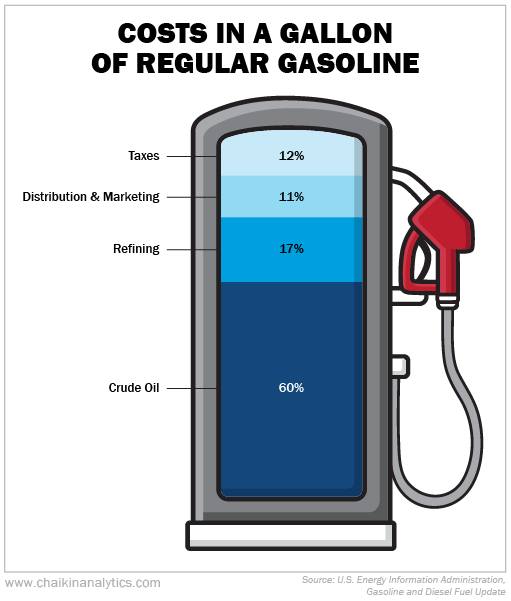If you own a car that uses gasoline, you’re going to need a part-time job to fill your tank…
In fact, things will only get worse. And unfortunately, gas could soon cost $10 per gallon.
It all comes down to basic math…
You see, each barrel contains 42 gallons of crude oil. And today, the price is roughly $110 per barrel.
That means the cost of materials in each gallon of gas is about $2.60 right now.
But there’s a problem…
It takes much more than just crude oil to get a gallon of gas in your car. Refining, distribution, and marketing costs are added along the way. And don’t forget about taxes.
Those pieces all add up to the price we pay at the pump. Right now, AAA data shows that the average price per gallon in the U.S. is about $4.60.
But we’re right on the edge of a “cascade effect.” And because of that, we’re much closer to $10-per-gallon gas than you likely realize.
Today, I’ll show you the cascade effect that threatens to send gas prices soaring…
Every week, the U.S. Energy Information Administration publishes its “Gasoline and Diesel Fuel Update.”
In short, this report provides a breakdown of each cost component in a gallon of gas. Take a look at the most recent update…

First, notice that the cost of crude oil makes up roughly 60% of the current price of regular gas. And in this breakdown, we also see how much other costs contribute to each gallon.
Now, imagine that crude oil soars to $216 per barrel. That’s not as crazy as you might think…
Crude oil’s all-time high was an inflation-adjusted $180 per barrel. It reached that mark during the summer of 2008. And frankly, the current volatility will only make things worse.
If crude oil were to hit $216 per barrel, that’s only about 20% higher than its all-time high.
When you fill in the numbers using that price for crude oil, it means gas would cost $8.57 per gallon. But don’t forget about the cascade effect…
You see, that $8.57-per-gallon price assumes marketing and distribution costs will stay constant. They won’t.
As gas prices soar, so do distribution costs. It’s a vicious cycle.
That means gas prices could easily exceed $9 per gallon. And soon enough, we could be paying $10 per gallon to fill up our cars.
That would lead to major problems for consumers. And by extension, it would be devastating for the market, too.
If gas rises to $10 per gallon, consumers will shut down all extra activity. They’ll reduce their driving to the essentials – like driving to work and going to the grocery store.
Don’t believe me? We’ve seen this play out before…
Again, gas prices last skyrocketed back in 2008. And according to the Department of Transportation, Americans drove 11 billion fewer miles in March 2008 than they did in March 2007.
By Memorial Day in 2008, demand for fuel showed its first annual decline in 17 years.
A Nielsen survey completed in December 2007 found that 70% of Americans were combining shopping trips and errands. And 41% of folks were eating out less at the time. Vacations weren’t even on the calendar unless they were to nearby destinations.
Folks, this scenario could happen again…
It’s a lot closer than you’ve likely realized. And we haven’t even touched on drilling restrictions and other attempts to appease climate-change enthusiasts in this essay.
Put simply, energy is a precious commodity. And we’re close to it becoming a lot more expensive.
So for now… keep your tank full.
Good investing,
Pete Carmasino